
A Diploma Thesis titled “The effect of anger on driver behavior and safety” was presented by Orestis Gavalas in July 2018. In order to achieve this goal, a driving simulator experiment was conducted and a questionnaire including the DAX scale was filled in a sample of 125 drivers. The collected data were grouped into anger components using the factor analysis method. Subsequently, both linear and logarithmic regression models were developed. Valuable conclusions were reached including men demonstrating higher levels of driving anger as well as that anger decreases with increasing age. The presence of anger is related to the increase in average speed, the reduction of headway (measured in time) and the increase in the probability of being involved in an accident and a road traffic infringement. On the other hand, forgiveness and noble mindedness lead to fundamentally opposite effects. ![]()
![]()

SafetyCube is a research project funded by the European Commission under Horizon 2020, the EU Framework Programme for Research and Innovation, in the domain of Road Safety. The latest SafetyCube newsletter is now available, highlighting the innovative road safety Decision Support System (DSS) which is online already one year, enabling policy-makers and stakeholders to select and implement the most appropriate strategies, measures and cost-effective approaches to reduce casualties of all road user types and all severities in Europe and worldwide. ![]()
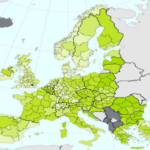
A Diploma Thesis titled “Critical driver behaviour and risk factors in Europe” was presented by Dimitrios Vachaviolos in July 2018. The aim of the present Diploma Thesis is the analysis of critical behavior and risk factors of drivers in Europe. To this end, we analyzed the responses of a representative sample of 17,980 European citizens who participated in the pan-European ESRA survey, which took place in 2016. The analysis of behavior and the investigation of the critical factors affecting driver behavior and safety, was carried out by using statistical methods of cluster analysis and binary logistic regression. The model results revealed that speeding leads to the increase of accident involvement probability, as is the case also for fatigue – drowsiness and distraction. ![]()
![]()
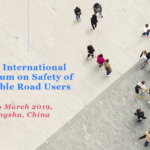
The ICoRSI International Symposium on Safety of Vulnerable Road Users was held in Central South University, Changsha, Hunan, China, on 25-26 March 2019. This was the second symposium in a series of which the first was held in Paris, France. The Conference theme was “Sharing Experiences on Safety of Vulnerable Road Users“. In addition to presentation of scientific papers, international experts was also to make keynote presentations on themes related to vulnerable road users. The conference encouraged participants to exchange research ideas and practical experiences dealing with: Statistics and surveillance, Safety campaigns, Education, safety and training, Enforcement of rules and legislation, Vehicle and safety equipment interventions, Infrastructure design and safety, Post-crash care of victims. ![]()
![]()

The World Road Association (PIARC) organized the XXVIth World Road Congress under the theme “Connecting Cultures, Enabling Economies“, in Abu Dhabi, United Arab Emirates, from 6 to 10 October 2019, jointly with the Abu Dhabi Department of Transport. The Congress has included 62 sessions, 13 workshops and 6 technical visits attracting over 6,000 participants from 144 countries, more than 3,700 delegates and more than 40 ministers and deputy ministers from around the world. 1,200 experts presented the results and conclusions of their work which were published in 40 technical reports and 4 online manuals. Road safety was a major component of the PIARC Conference. ![]()

European Commission – DG for Research and Innovation in their Success Stories Web-page recently published the SaferAfrica H2020 project, which has been taken place with the active contribution of NTUA. As a continent, Africa has some of the most lethal roads in the world. A lack of road safety protocols, wanting road conditions and poor post-crash emergency response systems make for alarmingly high fatality rates. To help turn this around, the EU-funded project SaferAfrica is driving policies aimed at improving road safety. “Europe can play an important role by supporting African countries in improving road safety and achieving the Action Plan targets [African Road Safety Action Plan 2011-2020],” says project coordinator Luca Persia. “In this view, the project aims at building favourable conditions and opportunities for the effective implementation of road safety actions in African countries by setting up a Dialogue Platform between Africa and Europe.” ![]()
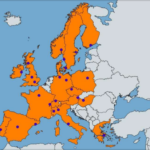
A Diploma Thesis titled “Mobility and Road Safety in European cities” was recently presented by Dimitrios Giagkou, focusing on the impact of mobility characteristics on road safety in European cities. For this analysis, various international databases (CARE, UITP, Eurostat) were exploited with data on road accident fatalities, demographics and mobility characteristics of 25 European cities in 2012. Generalized Linear Models were developed for both the total number of fatalities and for specific subcategories too. The results led to the conclusion that more public transport capacity offered, more cycle trips and fewer motorcycles lead to a reduction in the number of fatalities in urban road accidents. Moreover, it was found that denser road network, higher population density and higher GDP per capita are correlated with fewer fatalities in urban road accidents. ![]()
![]()

A Diploma Thesis titled “Impact of economic, social and transport indicators on road safety during the crisis period in Europe” was presented by Dimitrios Nikolaou in July 2018. For this analysis a database containing Human Development Index (HDI), suicides, passenger-kilometers and road fatalities for European states for 2006-2015 was developed. The results led to the conclusion that Human Development Index has the most important impact and its increase leads to road fatalities decrease. Moreover, the economy evolution effect on road accidents is more important than social and transport indicators. Especially after the economic crisis, the impact of the economy is even higher. Passenger-kilometers were also found with increased impact on the number of road fatalities after the economic crisis. ![]()
![]()

The 3rd Newsletter of the African-European Dialogue Platform on Road Safety (SaferAfrica) Horizons 2020 project has been recently issued with the active contribution of NTUA. This edition highlights the newly born African Road Safety Observatory, the African RSO and includes also the SaferAfrica recommendations on the implementation of the African Road Safety Action Plan and an attempt to answer how can the African Road Safety Observatory help to improve road safety in Africa. ![]()

A Diploma Thesis titled “Relation of the performance of road safety to medical, economic and social indicators to countries in the European Union” was presented by Myrto Damianou in July 2018. The 27 European Union Member States are studied between 2008 and 2014. Linear regression and linear mixed statistical model were developed. The results demonstrated important but different impacts of the examined indicators at the different countries and varying impact weight of these indicators. ![]()
![]()

A Diploma Thesis titled “Comparative investigation of road accidents cost in the European Union” was presented by Ypatia Mihou-Archimandritou in July 2018. For this analysis, social, economic and transport indicators from various international sources were exploited and a common database was developed, containing data about the rate of passenger cars use, GDP per capita, population, road accidents fatalities, suicides, number of passenger cars, Misery Index and other for the year 2015. The results led to a conclusion that an increase of the rate of passenger cars use leads to a decrease of the accident cost, while an increase of Misery Index leads to an increase of the accident cost. Furthermore, in economically strong countries higher accident cost is observed in comparison to the other two groups. ![]()
![]()
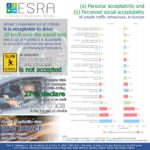
In the framework of the European Survey of Road users’ safety Attitudes (ESRA), NTUA released 3 new infographics, regarding “Drivers’ self-declared behaviour” ![]() , “Drivers’ attitudes towards unsafe behaviour”
, “Drivers’ attitudes towards unsafe behaviour” ![]() and “Drivers personal and social acceptability”
and “Drivers personal and social acceptability” ![]() .
.
ESRA is a joint international initiative of 26 research centers and road safety institutes; the project has surveyed road users in 38 countries on 5 continents. The purpose of this network is to collect comparable data on the opinions, attitudes, and behaviour of road users concerning road safety and mobility, and to provide scientific evidence for policy making at the national and international levels. The Updated Main Report (2017 edition) of ESRA has been published containing the results from the survey in 38 countries, including 13 Latin America countries.

A Diploma Thesis titled “Investigation of Drivers’ Preferences Towards New Innovative Vehicle Insurance Schemes” was presented by Emmanouil Konstantinopoulos in July 2018, with the support and data from OSeven Telematics. The objective of this Diploma Thesis is to investigate the most important factors that determine the demand of Greek drivers for vehicle insurance services comprising new innovative insurance schemes of Pay As You Drive and Pay How You Drive (PAYD & PHYD), taking into account critical characteristics of driving behaviour. The analysis demonstrated that the young and the female drivers show higher probability of selecting PAYD/PHYD schemes, while the Freelancers are more reluctant to such schemes. ![]()
![]()

The Department of Transportation Planning and Engineering of the National Technical University of Athens (NTUA) was ranked 15th in Europe and at 65th place worldwide among all Transportation Science & Technology Schools, ![]() according to the ShanghaiRanking’s Global Ranking of Academic Subjects (GRAS) 2018.
according to the ShanghaiRanking’s Global Ranking of Academic Subjects (GRAS) 2018. ![]() NTUA road safety activities have contributed to this excellent performance. Accordingly, the NTUA Civil Engineering School was ranked 7th worldwide (3rd European) among all Civil Engineering Schools.
NTUA road safety activities have contributed to this excellent performance. Accordingly, the NTUA Civil Engineering School was ranked 7th worldwide (3rd European) among all Civil Engineering Schools. ![]()

A Diploma Thesis titled “Modelling the economic impact of road accidents in Greece” was presented by Eleftherios-Marios Kourtis in July 2018. The objective of this Diploma Thesis is the estimation of the human cost of road accidents based on the “Willingness-to-Pay” (WTP) methodology, and the identification of drivers attitudes towards the probability of getting involved in a road accident, using the “Stated Preference” method. The results demonstrate a positive correlation between the number of road accidents that a driver was involved so far and the annual amount that is willing to invest. Furthermore, based on the WTP methodology, the road accident fatality human cost in Greece was estimated at 1.761 million euros. ![]()
![]()

EuroSafe, in collaboration with Luxembourg Institute of Health, organised European Conference on Injury Prevention and Safety Promotion 2019 (EU-Safety 2019) which took place on 03-04 October 2019, in Luxembourg. This Conference built on the series of European Injury Prevention Conferences successfully organised over the past decades by EuroSafe and the success of the World Safety-Conferences attended by a large European contingent. The main theme was: “Research for enhancing impact of strategies and actions”. The Conference brought together stakeholders in the prevention of accidents and injuries from Europe to exchange, debate and discuss the latest results in injury research, policies and practices. ![]()
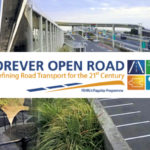
The new Forever Open Road website has been launched by FEHRL. The vision behind the Forever Open Road programme is to focuss on the best of existing technologies and the best of those to come. Many of the required solutions exist already from previous research, but are not (yet) implemented to their full potential; some innovations will be developed in the short-term, and others at an earlier stage of development with implementation in the longer term. Investigation on the untapped potential and the eventual barriers to their implementation will undoubtedly offer quick wins to the road operators. ![]()

The city of Edmonton organized the 10th Annual International Conference on Urban Traffic Safety, which took place with great success on 9-12 July, 2018 in Edmonton, Alberta, Canada. Just as all road users feel the impact of traffic safety, the responsibility to promote traffic safety was shared by many disciplines. This multidisciplinary approach is more evident now than it ever was before. When jurisdictions and agencies refer to Vision Zero Action Plans and Road Safety Strategies, their underlying theme revolves around collaborating with all partners whether they are engineers, enforcement officers, medical professionals, planners, political leaders, or public health representatives. ![]()

The Annual Road Safety Conference of the Bar Ilan University, took place with great success on 5th July 2018 in Tel Aviv, Israel. The conference dealt with pedestrians as well as with drivers’ behavior, the connection between them and solutions for improving safety for road users. This year the Keynote Speaker was Prof. Neville Stanton, PhD, DSc, Head of Human Factors Engineering in the Faculty of Engineering and the Environment, University of Southampton, UK, and his presentation concerned: “Driver Reactions to Vehicle Automation”. ![]()
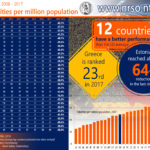
According to the EU road fatalities infographic of the NTUA Road Safety Observatory, twelve countries have a better performance than the EU average, namely Sweden, UK, Netherlands, Denmark, Ireland, Estonia, Germany, Finland, Spain, Malta, Austria, and Luxembourg. Greece has been ranked 23rd in 2017. Estonia demonstrated the highest road fatalities rate reduction (64%) in the last decade, followed by Lithuania (57%), whereas the EU average 10-year reduction is 38% and for Greece is 51%. ![]()
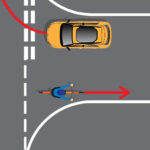
Serious crashes on inter-urban roads may be slashed by a quarter over the next 30-40 years with the introduction of automated vehicles. However, the journey may be far from easy, with a mixed fleet transition and vital need for roads that cars can read, according to recent Report released by EuroRAP. The Report, the third in the “Roads that Cars Can Read” series, examines the relationship between road infrastructure and safety for conventional and increasingly-autonomous vehicles (AVs) and provides a framework for infrastructure safety investment. ![]()
![]() Other Reports in the series: “Roads that cars can read I: A consultation paper” – 2011 and “Roads that cars can read II: A quality standard for road markings and traffic signs on major rural roads” – 2013.
Other Reports in the series: “Roads that cars can read I: A consultation paper” – 2011 and “Roads that cars can read II: A quality standard for road markings and traffic signs on major rural roads” – 2013.

The Annual European Safety and Reliability Conference ESREL 2018 is an international conference under the auspices of the European Safety and Reliability Association (ESRA), which took place with great success on 17-21 June 2018 in the Norwegian University of Science and Technology, NTNU, Trondheim, Norway. The topic for ESREL 2018 was “Safe Societies in a Changing World” and the goal of the conference was to advance in the understanding, modeling, and management of the complexity of the risk, safety and reliability fields characterizing our world, now and in the future. ![]() NTUA actively contributed with the following presentations:
NTUA actively contributed with the following presentations:
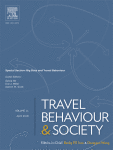
A paper titled “Public opinion on Usage-Based Motor Insurance Schemes: a stated preference approach” authored by Dimitris Tselentis, Akis Theofilatos, George Yannis and Manos Konstantinopoulos is now published in Travel Behaviour and Society scientific Journal, with the support and data from OSeven Telematics. This paper aims to investigate which parameters affect users’ willingness to pay for alternative usage-based motor insurance pricing schemes such as Pay-as-you-drive (PAYD) and Pay-as-how-you-drive (PHYD). Results indicated that women and smartphone owners are more likely to choose a new insurance schemes. Kilometers and cost reduction were also found to affect similarly the choice for both Usage-Based-Motor Insurance (UBI). Moreover, the higher the speed reduction imposed to the driver, the lower the probability of the UBI scheme to choose it. ![]()


NTUA Professor George Yannis gave a Lecture at the European Commission – DG for Research and Innovation on 11 June 2018 in Brussels, titled “Road Safety in Africa and Beyond“. The Lecture focused on various aspects of road safety in Africa and worldwide, on the the SaferAfrica research project and on the respective EU international cooperation policies in the field, followed by a vivid discussion on key road safety problems and the EC role for potential policies, programmes and measures for the improvement of road safety in Africa and worldwide. ![]()
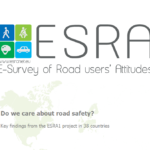
The Updated Main Report (2017 edition) of the European Survey of Road users’ safety Attitudes (ESRA) has been published containing the results from the survey in 38 countries, including 13 Latin America countries, with the active contribution of NTUA. The updated version of the ESRA webpage with Deliverables and Publications includes the 2017 Main Report in 3 languages (English, Spanish, French), six Thematic Reports on European drivers attitudes, and the country fact sheets. ![]()

The European Union Road Federation (ERF) and the Federation of European Motorcyclists’ Associations (FEMA) have published a joint position paper, called ‘Improving infrastructure safety for powered two-wheelers’. Only in 2017 power two-wheelers fatalities (motorcycles and mopeds) counted for 17% of the total road victims, while accounting only for 1,8% of the total traffic flow. Both ERF and FEMA strongly believe that road safety for motorcyclists can be significantly improved by looking at the design of road infrastructure. ![]()

The Road Safety Institute Panos Mylonas together with the European Transport Safety Council (ETSC) and the support of the Brewers of Europe, organised an international conference on tackling drink-driving as part of the SMART (Sober Mobility Across Road Transport) project which took place with great success in Athens, Greece, on 21 June 2018. The debate addressed policy and practice on enforcement, penalties, rehabilitation, alcohol interlocks and other measures to discourage and prevent drink driving, with focus on improved driver behaviour and safety performance in Greece. ![]()
![]()
![]() NTUA presentation concerned: Drinking and driving in Greece
NTUA presentation concerned: Drinking and driving in Greece ![]()

The Transportation Public Health Link (TPH Link) organized the International Conference on Transport & Health (ICTH) which is a direct participatory event. Policy-makers, practitioners and academics from multiple disciplines involved in transport planning and engineering, public health, urban planning, spatial and architectural design, environmental planning, economics and beyond took place on Mackinac Island, Northern Michigan, on 24-27 June 2018. The theme for ICTH 2018 – Mackinac Island focused on contrasting rural and urban transport and the environmental factors that impact quality of life, health and well-being; making rural transport sexy. ![]()
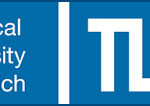
The Focus Area Mobility & Transportation Systems of the Technical University of Munich (TUM) organized the International Scientific Conference on Mobility and Transport (mobil.TUM 2018) which took place with great success on June 13th – 14th 2018, in Munich, Germany. The theme of the conference was Urban Mobility – Shaping the Future Together. Road safety was one of the key discussion areas enabling inspiration from the latest innovations and exploring new directions for shaping the future of urban mobility and safety. ![]() NTUA actively contributed with the following presentations:
NTUA actively contributed with the following presentations:

 How an unexpected incident affects speed related driving performance measures
How an unexpected incident affects speed related driving performance measures
 Exploring Crash Injury Severity on Urban Motorways by Applying Finite Mixture Model
Exploring Crash Injury Severity on Urban Motorways by Applying Finite Mixture Model
 Utilizing Real-time Traffic and Weather Data to Explore Crash Frequency on Urban Motorways: A Cusp Catastrophe Approach
Utilizing Real-time Traffic and Weather Data to Explore Crash Frequency on Urban Motorways: A Cusp Catastrophe Approach






















































































































































































